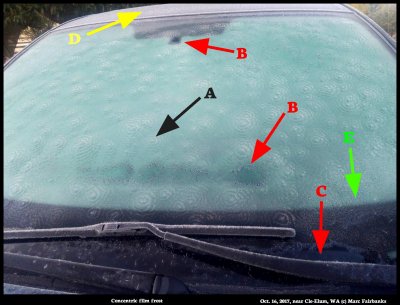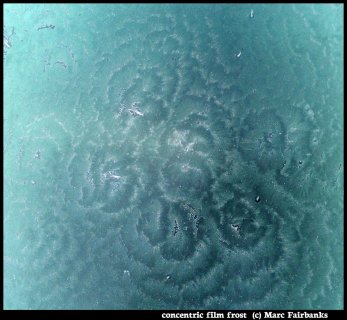| « New paperback edition out, Sept. 2017 | A complete picture book of all (known) snow types » |
Concentric Film Frost
October 16, 2017, the first frost of the 2017-18 winter as far as I know. Frost in Eastern Washington anyway, those of us on the west side of the Cascade Mts have not gotten any yet. Marc Fairbanks, an avid nature observer from the mountains near Cle Elum, sent me the following shot (click on the image to fully appreciate the pattern).
This is primarily film-frost, that is, is based on ice that formed when liquid film froze. But as I discussed in a previous post, some important growth processes here also occur through the vapor phase:
http://www.storyofsnow.com/blog1.php/crystal-to-crystal-communication-through-vapor-and-heat
I had even earlier noted some "ripple" patterns on a windshield and mused about their formation:
http://www.storyofsnow.com/blog1.php/ripples
As I'll discuss next, there are some other illuminating observations here.
Consider first the obvious features, an example marked "A" below:
Looking closer at such features:
We see that the centers may be white or dark. Then bands of white crystals and darker regions lacking crystals alternate outward. Bands from one center collide with bands coming from another center, making a bizarre, maze-like pattern. As described in my previous post (link above), this banding likely occurs due to the crystals "scavenging" the nearby vapor and their heat of crystallization warming up the nearby glass. The nearby region becomes devoid of water, doesn't crystallize, but the evaporation cools the nearby region, spurning a new crystallization band. The thermal process mentioned here would work best on a material such as glass that has a low thermal conductivity. On metal, which has a high thermal conductivity, the pattern is more rare and the bands spaced much further apart (see the above-mentioned previous post for an example). Note how the metal roof of the car ("D" arrow in image) does not show this pattern.
A few other things to note. At arrows marked "B" and "C", the pattern vanishes. Why?
For various reasons, these spots had less water film to start with. The main reason they had less water film is because they were slightly warmer than the surrounding regions (it takes very little temperature difference). At the top "B" spot, the rear-view mirror is attached, giving the region a greater thermal capacity; that it, it takes longer to cool. At the lower "B", the region below had the air vents, so cooling would lead to some stirring of the air below, with relatively warmer air rising up through the vents. At "C", there is likely the larger thermal mass effect, as well as some vapor scavenging from hoar frost on the windshield wiper blades. The wiper blades would also radiate heat down to the glass, much as the branches of a tree radiate heat down, preventing dew formation on grass under trees. As I said, it doesn't take much.
Finally, what about the different pattern at "E"?
I don't know!
-Jon


